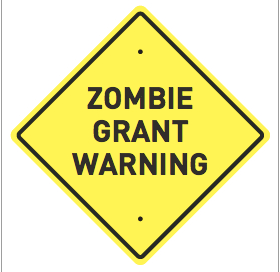 Last week I explained how to tell if your grant application is misshapen. This post is about how to get it into shape.
Last week I explained how to tell if your grant application is misshapen. This post is about how to get it into shape.
Let’s start with the most difficult kind of draft to deal with, one in which it’s hard to tell the shape of the proposal because it’s written in such a way that you can’t tell what a paragraph is about until you have analysed its meaning. Last week I described this kind of writing as zombie text.
The first step with zombie text is to identify the topic of each paragraph. The next step is the same with zombie text and with text where the paragraph starts with the topic. It is to find the best grouping of paragraphs into larger subsections.
Dealing with Zombie Text
The first step with zombie text is to use the reverse outlining procedure described on @thesiswhisperer’s blog about the zombie thesis to identify the paragraph topics. There is another description of reverse outlining on @explorstlye’s blog, Explorations of Style.
- Number the paragraphs in your draft. Open a new document, give it a different title and copy the whole text of your draft into it.
- Replace each paragraph in the new document with a single short sentence that states its point. Keep the numbering so that you can copy across the remaining text from the original document when you need to.
- If you can’t state the point of a paragraph with a single sentence then you probably need to revise your approach to paragraphs. There is good advice in the explorations of style blog and in lots of other places on the web. For this exercise just split the paragraphs into smaller chunks that canbe summarised with a single sentence and give them compound numbers (2.1, 2.2 etc).
If your draft is written so that the first sentence of each paragraph states the topic of the paragraph then you simply number the paragraphs and create a new document containing just the first sentence of each paragraph, still numbered.
In the reverse outlining process you rearrange the order of the topic sentences until you find the best structure for your document. With grant applications we already know what the best structure is, so the task is to arrange the text in that structure. We start with the largest component of the case for support, the description of the project.
Description of the project: key sentences and topic sentences
The next step is to sort the topic sentences of the paragraphs on the research project into five or six sections. In order to do this you will need to have worked out the main details of your research project. At the very least you will have divided the project into three or four sub-projects and you will know what outcome each sub-project will produce.
 If you haven’t done this then I am afraid I have bad news. This post will not help you: you have a zombie grant. There is no point in rewriting it until you have designed a project.
If you haven’t done this then I am afraid I have bad news. This post will not help you: you have a zombie grant. There is no point in rewriting it until you have designed a project.
I’m sorry if this is disappointing but I can’t change the facts of life. The best I can do is to help you deal with them. A grant application is a marketing document for a research project. Without a research project, it can never be more than an empty shell, a zombie.
The best help I can offer is to say that the text you have written may be useful but you need to design a project in order to use it. This post tells you how to design and catalogue sub-projects and this post tells you how to check whether a particular group of sub-projects makes a viable project. I will deal more specifically with zombie grants in a future post.
So, if you have a potentially viable grant application you need to sort the topic sentences into five or six sub-sections as follows:-
- a general introductory section,
- three or four sections describing the specific sub-projects, and
- a section saying what you will do with the overall results of the project.
You should now select, or draft, a key sentence that will be the first sentence for each of these five or six sections. This post tells you how but here’s a rough outline.
- The key sentence for each sub-project should say something about what the research activities are in the sub-project and it should say what they will discover or what the outcome will be. It has the form [Very brief descripton of research activities in the subproject] will [show, discover, reveal, or other suitable verb] [whatever the outcome of the research in that sub-project will be]. If you have written such a sentence, by all means use it, but if you haven’t, you need to write it now.
- As you write each of these key sentences you should write a corresponding key sentence for the background to the project and paste it into the corresponding sub-section of the background of the case for support. This sentence states that we need to know whatever the corresponding sub-project will discover. The general form is We need to know [or discover, understand or similar verb] [the outcome of the research in the corresponding sub-project].
- The key sentence for the introductory sub-section on the research project as a whole should say what kind of research it will involve, something about the facilities it will use – especially if these are distinctive in some way, and what it will discover.
- The key sentence for the sub-section on what you will do with the overall results may be about publication or about dissemination or exploitation of the results in some other way.
Once you have the key sentences in place you should copy each numbered topic sentence into the section where it fits best. Then arrange them in the best possible order. Now you are ready for the detail.
Final shaping of the description of the project
Once you have the topic sentences in the right order you should take text from the body of each original paragraph and edit it so that the paragraphs flow internally and from one to the next. The introductory subsection should contain a description of your general research approach together with any necessary preliminaries. The sub-sections corresponding to the sub-projects should contain a coherent description of your intended research activities that makes it clear how they will lead to the result mentioned in the introductory key sentence.
This is the point at which you adjust the length. Remember, the full description of the project should be at least 50% of the case for support. If it is more than about 65% then you either have too much detail or too big a project. Keep adjusting and trimming until you have a description of your research project that is the right size.
The next step is to produce a background section that convinces the reader that we need to know what your research project will discover. You already have key sentences that define three or four of its five or six subsections. I will tell you how to produce the rest of it next week.
